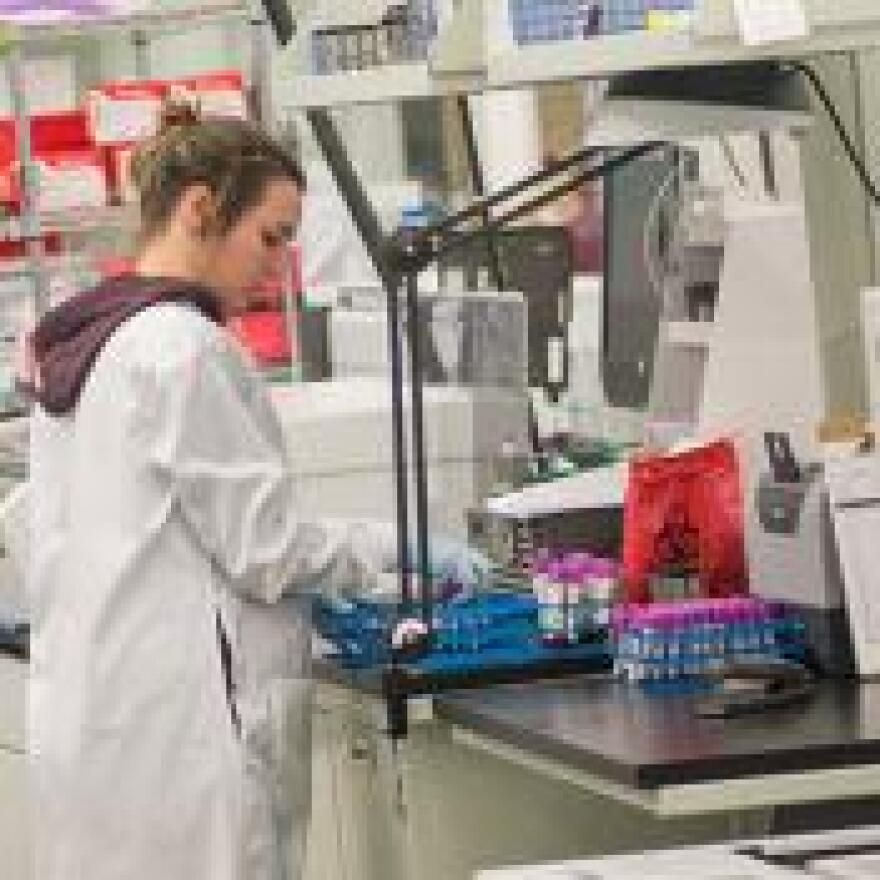During the last decade, Northeast Ohio’s stature as a bio-medical innovation and production hub has grown to rival Minneapolis, the historic Midwest frontrunner. As part of our series, “The Business of Health,” WKSU’s Kevin Niedermier looks at what’s fueling the rising economic role of the region’s bio-medical industry.
After searching the country for a place to start a business, in 2009 Jake Orville chose Northeast Ohio.

That year he started Cleveland HeartLab, a diagnostic company that uses blood and urine samples to quickly identify potential cardio-vascular problems. Here at the company’s expansive laboratory built in a former industrial area near downtown Cleveland, lab-coat clad technicians are testing samples from around the country.
“And when I came to Cleveland I had just left the coasts. I had spent a lot of time with tech transfer offices in Silicon Valley and in Boston and even in Chicago looking to start a company. Someone convinced me to come to Cleveland. While I had done business with great medical centers like U-H and the Cleveland Clinic for most of my career, I didn’t quite understand how much innovation and technology was coming out of the Cleveland area until I came as a potential entrepreneur and as someone who wanted to start a company.”
Exponential growth
Orville started with eight employees and now has 150 people testing blood and urine, shipping and receiving samples, and doing sales, marketing and accounting. Jacob Duritsky is the head of strategy and research for the regional economic development organization Team NEO. He says bio-tech companies like HeartLab are among the region’s fastest growing business sector.

“We’ve grown from about 300 companies in 2002 to more than 700 biomedical companies in 2014 employing north of 30,000 people.”
Duritsky says that accounts for about three percent of the local economy, and is growing along with the burgeoning health care industry, the region’s largest employer followed by manufacturing.
Cross-pollination
AramNerpouni is head of the medical product incubator BioEnterprise. He says in the early 2000’s the region’s hospitals, universities, manufacturers and government officials started working together to aggressively pursue medical innovation. And Midwestern bio-med leader Minneapolis represented the standard they wanted to reach.
“While we were seeing three or four deals a year bringing in $30 million, they were seeing 25 deals a year

bring in $150 million. And so that was really our collective benchmark together. And so over the last little bit more than a decade we’ve gone from that three or four deals and $30 million, now have hit three years in a row over $200 million coming into the region. In 2014 we had just shy of $400 million coming in and consistently seeing 40, 50 companies a year raising money.”
Now, Nerpouni says during the last six-years, Northeast Ohio and Minneapolis have been going back and forth as annual leaders in midwest venture capital attraction for bio-med. Research at Northeast Ohio medical institutions and universities coupled with the region’s manufacturing base, and a drive to do whatever it takes attract investors has bolstered the growth in bio-med investment.
Chinese investment
One of those financiers is SCI, an investment firm from Shanghai, China. At the company’s booth at this year’s Cleveland Clinic Medical Innovation Summit, managing partner Donald Tang explained why his company has invested millions of dollars in Northeast Ohio medical companies since 2006.
“We started in 2006 by chance. But then later on, the people here are so friendly and so open to introduce new technology to us, and are so much focused on doing their own job so diligently. We respect the people here. And they share their vision, they share their knowledge, they share their resources with us. So why not put more money here.”

Tang has opened an office in Cleveland, and plans to invest $50 million in Northeast Ohio companies in the next few years.
Supplying a workforce
AramNerpouni of BioEnterprise says the region has proven it can generate enough innovative ideas to attract funding, and has the infrastructure in place support product development. Now, he says the next big step is filling the growing number of positions.
“It could be coming from someplace else and moving to Cleveland. But I think over time we have to demonstrate that we can grow local talent so that a kid in the Cleveland public schools or the Akron public schools knows that we have this thriving biomedical economy and can see the pathway that they can get there. They can get there through manufacturing, they can get there through becoming a doctor and innovating themselves. They can become an entrepreneur, they can get into coding and programing and things like that.”
Team NEO predicts that in Northeast Ohio, the occupations that support the bio-med industry, including science and technology, assorted health care professions, IT and management will be among the region’s fastest growing. The overall local healthcare industry is predicted to generate 85,000 job openings over the next 10 years.









